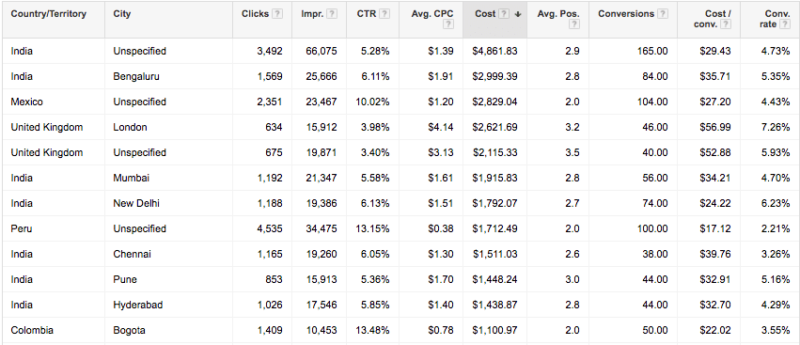 When campaign budgets are capped, it is more important than ever to get the best performance from your campaign. Since we can’t spend money on everything, we have to figure out how to get the most return out of the money that we have.
When campaign budgets are capped, it is more important than ever to get the best performance from your campaign. Since we can’t spend money on everything, we have to figure out how to get the most return out of the money that we have.
Know what drives value
First things first, we have to be able to understand what is truly driving value.
With e-commerce sites, it’s a little easier because the return on ad spend (ROAS) is easily tracked and tied back to campaigns. To take it one step further, it is best to understand which campaigns (or, more specifically, keywords) are driving the most lifetime value.
For lead generation, it can be a little harder. The cheapest leads aren’t always the best leads, and the best cost per action (CPA) doesn’t always equate to the best performance.
Setting up tracking to determine close rates is really important to understand what is working. As with e-commerce, understanding lifetime value is even better, so that we can make sure money is allocated to the best-performing campaigns.
Trim wasted spend
Once I know what’s working, I start to cut out things that aren’t. I dig into all of the details of the account where wasted spend could go unnoticed.
The Dimensions reports (or in the new AdWords interface: The Predefined Reports) are a good place to start.

The Dimension report (old AdWords interface)

The Predefined Report (new AdWords interface)
I look for anything I can cut that won’t have a proportional impact on results:
- Locations that are spending without producing.
- Time frames that should be excluded.
- Time frames that should bid down.
All of these things may seem small, but they add up.
I then dig into keywords and ad groups. I look at different time frames, including recent performance but also long-term performance. When auditing accounts, I’ve found that a lot of keywords go unnoticed because they aren’t huge spenders but, in looking at a longer time frame, they may have spent a significant amount without producing results.
Likewise, I look at ad groups through the same lens. It could be that none of the keywords within the ad group are spending at a significant rate, but in aggregate they may have spent a substantial amount without performing.
In these scenarios, I label the ad group and keywords so that I can reactivate them in the future for testing. It may seem premature to cut them, but the short-term goal is to have a laser focus on top performers.
Max out the right things first
On the flip side, I look for what is working well. As I’m digging through all facets of the campaigns and looking for what isn’t working, I also take note of what is likely the best ROAS and sustainable volume.
Most importantly, I ask:
- What is being hampered by budget caps?
- Where is there an opportunity to increase the volume of sales and maintain a strong ROAS if only budget caps could be lifted?
The idea is to try to find ways to give those situations more runway. Whether certain locations are driving a high amount of volume at a low cost, or a device, a select number of keywords, or some combination of factors — I like to separate the high performers into their own campaign so that budget can be opened (as much as possible) while maintaining tighter caps on lesser-performing auctions.
Know when to use and not to use shared budgets
Shared budgets can be a godsend when it comes to budget-capped campaigns, or they can be crippling.
 I typically look to shared budgets in situations where the max cost per click (CPC) within the campaigns is close to or above the campaign budget. (Yes, it happens!)
I typically look to shared budgets in situations where the max cost per click (CPC) within the campaigns is close to or above the campaign budget. (Yes, it happens!)
Sometimes, as budgets get pulled back, then pulled back again — unknowingly, keywords performance is hampered because the bids are so close to the campaign budget.
Granted, with AdWords now having the ability to double campaign budgets, this alleviates a little bit of this strain but doesn’t entirely resolve it.
When implementing, I group campaigns with like performance together. One of the pitfalls of shared budgets is that you can’t control how the budget is prioritized. I never want a poor performer to suck up all of the budget. I set up multiple shared campaigns if needed, to ensure top performers aren’t competing against poor performers for a budget. If performance is inconsistent across all campaigns, then shared budgets probably aren’t the best fit.
Last but not least, I never lump search and display campaigns into the shared budget. Display campaigns, if allowed, can absorb a lot of budgets, so I always keep those separate.
Bidding to maximize budget
There are also some bidding opportunities that can help maximize impact on a capped budget. A few options that I like to try include:
- Decreasing positions. I take a look at average positions. If we’re maintaining positions in the 1-2 range, I like to test decreasing bids to see if we can get more clicks at a lower CPC without losing ground on conversions.
- Testing bidding strategies. I also like to set up experiments within campaigns to test different bidding strategies, such as maximizing conversions and optimizing for CPA.
As with any test, sometimes these improve performance and sometimes they don’t, so I just keep track and then roll out whichever performs best.
Increase your conversion rate
Another surefire way to improve return, even on a limited budget, is to improve conversion rates.
Increasing your conversion rate ensures that you get the most sales out of the traffic that you drive to the site. Best of all, increasing your conversion rate can have an impact across multiple channels — not just search — so the impact can be disproportionately positive. If you can’t increase budget but need to scale, the best way to increase production is to focus on conversion rate.
The post Surefire tactics to get the most value out of budget-limited campaigns appeared first on Search Engine Land.
No comments:
Post a Comment